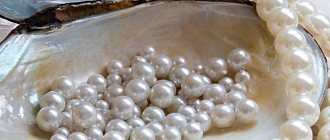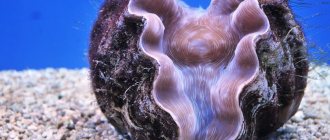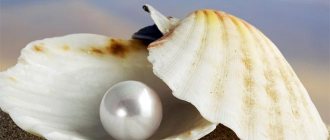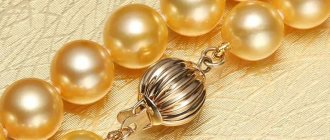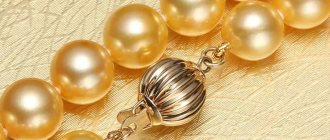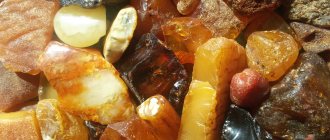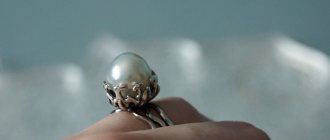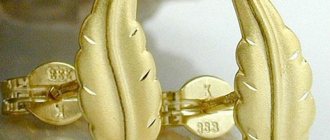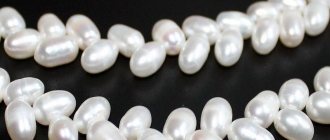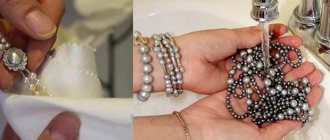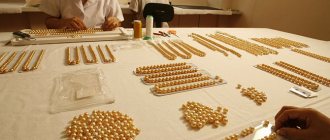The smoothest and most beautiful pearls are used to make necklaces, bracelets and other jewelry. The popularity of pearl products is very high. Fashionistas love the warm, mesmerizing color of iridescent pearls. There is something enchanting and mysterious about it. Pearls give their owners health and longevity. But it can die if it is not properly cared for and stored. Mother of pearl is very sensitive to ultraviolet radiation, humidity, and chemical compounds.
There are river and sea pearls. River is extracted from clean rivers, sea from the bottom of the sea. Fishing is a method of extracting pearls from mollusk shells.
Fishing method in the Gulf of Manara
The places where pearl mussels gather are on the sandbanks. Fishing begins in March, when there are no storms. The entire bay is divided into equal sections, and mining is carried out in one of the sections to prevent depletion of shellfish stocks. Fishing begins when a certain number of pearl mussels accumulate. The fishery is monitored by supervisory authorities. Collection of shells from the seabed is carried out mainly by hand by divers. These are people who are taught by their parents from an early age. They extract shells without special equipment. The shells are brought ashore and most are rented to the government, the rest are divided among the divers, helpers and the boat owner. People who buy shells put them in special containers and leave them in the sun for several days. Parts of the shellfish rot and people take out large pearls, then collect small pearls by washing parts of the shellfish.
Physico-chemical properties of pearls
Pearl is an organomineral consisting of an aggregate of calcium carbonate and a horny substance, conchiolin. In other words, a calcareous organic compound that arose as a result of the protective reaction of the mollusk body to a foreign substance.
Advertising - Continued below
Pearls come in a variety of colors: cream, silver, pink, white, dark gold and even blue and black. There are more than a hundred shades. The palette depends not only on the types of pearl mussels, but also on the place of their birth, the chemical composition of the water and the maturity of the pearls themselves. Maturity is measured in microns of thickness of the aragonite plates. The most brilliant, and therefore the highest quality, layers are considered to be those with a thickness of half a micron. Basically, these are not river pearls, but sea pearls.
Pearls of different colors. Photo: emaze.com
Pearls are a very fragile and delicate gemstone. Its hardness is only 3-4 on the Mohs scale, and it is easily scratched by any sharp object. Density ranges from 2.6 to 2.78 g/cm3.
When exposed to X-ray or neutron irradiation, freshwater pearls darken to black; sea pearls react to irradiation only with the core, remaining light on the outside.
Islands of Bahrain and Qatar
High quality sea pearls of a soft pink hue are mined here. Divers extract shells from a depth of 15 meters. The only clothing is a loincloth; the nose is pinched with a bamboo clothespin. She collects the shells in a wire basket. An assistant remains in the boat and lifts the basket. If the team leaves for several days, then a singer goes with them, who entertains the catchers by singing songs. Hard work and prolonged exposure to salt water lead to exhaustion of the body and early death of pearl divers. For this reason, pearls are called “tears of the bay.” Production has decreased due to artificial methods of pearl cultivation and the discovery of oil production in the regions.
How to care for pearls
Due to their organic origin, pearls are quite short-lived.
It swells in water, and when it dries, it crumbles and disintegrates. It is poorly affected by acids and cosmetics. Under their influence, color and shine are lost. Pearls gradually age, their “life” is about 100-150 years. In order to preserve its beauty, the stone is cleaned with salt water at least twice a year. If the pearl has lost its shine, then you can dissolve the top layer in acid and get a beautiful stone again.
Socotra Island and Gulf of Aden
They are famous for their rare pearls with a lead tint. Pearls are also obtained in the old way with the help of divers. Since the sea in these places is teeming with sharks, fishing is carried out only during the season when there are fewer of them. The swimmer's equipment consists of a diving weight and a basket for shells. To examine the bottom, use a special mirror, which represents a box with a glass bottom. The bottom of the sea is visible from the boat, and the swimmer descends behind the shells. In order not to breathe, a clothespin made of a cow's horn is put on the nose. This is a tribute to centuries-old traditions, since children inherit the work of their parents.
Pearl jewelry
The following types of pearls are used for jewelry:
- freshwater, mined in Russian rivers, reservoirs of North America, Germany and China;
- pearls from the southern seas near Australia, Polynesia, the Philippines, Indonesia and Myanmar;
- stones from the seas near Japan - they are most valued because they have a beautiful shine.
Precious material in jewelry is used independently or as an insert. Therefore, two product options are distinguished:
- necklaces, pendants, bracelets and frameless necklaces;
- rings, earrings and pendants with a metal frame.
Precious or simple metals are used as jewelry settings. Their choice is influenced by the origin and quality of the pearl.
When purchasing a product with pearls, you need to carefully select it, since the jewelry is not suitable for all people:
- for women with dark skin types, only golden or peach pearls are suitable;
- ladies with fair skin types should opt for pinkish stones;
- It is desirable that the shade of the mineral be in harmony with your wardrobe or eye color.
An assortment of pearls of any type and cost is sold on the domestic market. The price of jewelry is determined by the origin of the stones and their quality. It is also affected by the material of the frame used.
Australia
Pearl fishing is carried out in the Torres Strait, and fishing is also carried out along the entire north-west coast. Australians have adopted the Japanese method of growing pearls on special farms, and now it is a full-fledged industry that brings in good income. Pearls grow faster and larger here than in Japan.
Previously, the waters of the seas and oceans were abundant in pearls, but now the reserves have been sharply depleted. This happened due to predatory fishing, when tons of shells were destroyed for the sake of one pearl. Environmental changes and pollution of the seas and oceans have led to the death of many shellfish.
RUSSIA – THE CRADLE OF THE WORLD’S PEARLS
The history of pearl mining in Russia goes back more than a thousand years.
- The fishery was first mentioned in documents dating back to the 10th-12th centuries.
- The “golden time” for pearl mining in Russia came about two hundred years after the first mentions.
- Starting from the 14th-16th centuries, probably only the lazy were not involved in the extraction and sale of mother-of-pearl in Russia.
- The mineral was abundant in Arkhangelsk, Moscow, Novgorod, Kazan, Perm, Yaroslavl, St. Petersburg, Vyatka and many other provinces, on the Kola Peninsula and Karelia.
The most active mining of mother-of-pearl was carried out in the northern provinces of Russia. A third of all gem-quality stones have been mined since the days of the northern rivers.
| Type of mineral mined in Russia | river |
| Number of pearl rivers | 150 |
| Provinces rich in pearls | Karelia, Kola Peninsula, Arkhangelsk, Perm, Vyatka, etc. |
| Export volume | Until the end of the 19th century, Russia ranked second in terms of pearl exports after India. In 1860, the empire sold almost a billion rubles worth of mother-of-pearl abroad at the current exchange rate. |
Karelia
To the pearl mines - by gender
In Russia, only men were involved in pearl fishing. Before going “hunting” for mother-of-pearl, hunters were required to attend a church service, wash in a bathhouse and put on clean clothes.
The peak of production in Russia occurred in the summer, when the water level in the rivers decreased. The shells were located at a depth of up to one meter. Therefore, fishermen often went for pearls by wading, armed with a special tool similar to tongs, or by rafting.
In Russia there was a belief that only people who were pure in soul and heart could engage in mother-of-pearl mining. An evil person will not get pearls. Apparently, there were enough good people in Rus'. We recommend: What are the varieties and types of PEARLS?
The amount of pearls in the domestic treasury was amazing:
- In 1611, the Poles, who took the Kremlin, fired large pearls from muskets out of idleness.
- About 40 years later, during the Salt Riot in 1648, the rebels who got to the royal treasures sold pearls by the capful.
- No historical vicissitudes could shake Russia’s position as one of the leaders in the extraction of freshwater pearls. The country retained this status until the end of the 19th century.
- During this period, the Russian Empire exported mother-of-pearl worth 182 thousand rubles at that time. This is almost a billion at modern exchange rates.
Pearl mines
Interesting facts about royal pearls
Jewelry and outfits generously embroidered with pearls were very popular in Rus'.
So much mother-of-pearl was mined in the country that even poor peasant women could afford beads.
Real jewelry masterpieces were kept in the boxes of noble people. Moreover, not only women, but also men.
The most severe rulers and autocrats sported mother-of-pearl:
- If you believe the chroniclers, even Prince Svyatoslav, who ruled back in the 900s, could not resist. The ear of the famous commander was decorated with a pearl earring.
- Prince Ivan Kalita had a belt embroidered with mother-of-pearl beads. There are also legends about the robe of Ivan the Terrible, supposedly strewn with pearls the size of nuts. Included with the mantle was a royal headdress, which also featured river mother-of-pearl.
Nacre
- Pearl mining flourished in Russia, so the outfits of the reigning persons became more and more luxurious. Tsar Fyodor Alekseevich surpassed Ivan the Terrible in the luxury of his attire. In 1678, he received Polish ambassadors in a robe on which there were so many pearls and diamonds that it seemed to foreigners as if the monarch was “decorated with the sun and stars.”
- Pearls were held in high esteem by fashionistas from all over the world. One of Catherine the Great's favorite pieces of jewelry was a necklace made of 30 rare black beads.
- But Elizabeth I did not limit herself to one thread of mother-of-pearl. She usually wore pearl necklaces in several rows.
- However, the accessories of Russian rulers are child's toys compared to the jewelry of the French Empress Marie de' Medici. Just imagine, her weekend outfit was decorated with 30 thousand pearls.
- The last Russian Empress Alexandra Feodorovna, the wife of Nicholas II, was also distinguished by a passion for the organic mineral. Many people know about the habit of the crowned couple to exchange such “trinkets” as Faberge eggs during the holidays. But the tradition of pearls “from Bolin” is not so widely known. Every April, on the anniversary of the engagement, Alexandra Feodorovna received pearl jewelry from her husband, made in Russia by the company “Karl Eduard Bohlin”. The gifts cost the monarch a fortune—in just eight years, he spent half a million rubles on them.
Marie de Medici's outfit
Karelian mines
The beauty of Karelia’s nature, its clean rivers full of salmon fish, has been known for a long time. Once upon a time, this corner of Russia had all the conditions for pearl mining.
We recommend: CLEANING PEARLS with your own hands
Local flowing rivers, where cold water flows slowly and there are almost no potassium and magnesium salts, are very popular with margaritans. It is a type of organic mineral that has been dubbed the “mother of pearls.”
Several centuries ago, the extraction of freshwater pearls in Karelia, as in almost all of Russia, looked like this. The catchers made a raft with a small hole in the middle. The hole was needed to stick your face through and observe the treasures of the river bottom. In smaller bodies of water it was possible to do without a raft. The men collected shells while standing waist-deep in water.
Pearls were mined from July to August, by which time the Karelian rivers had time to warm up and the water level had dropped.
To make it easier to determine the price of freshwater pearls, local businessmen divided the stones of Karelia into three categories - large, medium and small.
“Sloping” mother-of-pearl beads of an ideal round shape, which easily rolled down an inclined surface, were especially held in high esteem.
Karelian mines
Extraction in Japan: cultured pearls
The price of natural pearls has dropped dramatically since cultured pearls began to be grown in Japan. The Japanese adopted technology from China, who tried to grow pearls artificially thousands of years ago. They placed small pieces of baked clay, bone or copper between the shell flaps. The shells were returned to the lake for 2-3 years. Mother-of-pearl figures were formed. They also placed miniature images of Buddha.
Many European and Russian scientists were engaged in growing artificial pearls, but only the Japanese K. Mikimoto patented his invention and created a pearl farm. It took years of hard work to achieve a good result. Initially, Mikimoto pearls were not of jewelry quality. Over time, he came up with the latest technology, which made it possible to obtain good pearls of the desired shape and shine. Their cultivation is quite capable of competing with natural sea pearls.
Now Japan is the undisputed leader in the cultivation of cultured pearls. There is Mikimoto Island, where there is a museum and a laboratory for growing pearls.
WHERE ARE PEARLS MINED?
As it turned out, the population of wild pearl mollusks has declined sharply. However, there are still places where pearls are found in natural conditions.
- The origin of wild pearls can be determined by their shape, color and size. The type of oysters also matters.
- The largest wild pearls are found off the coast of Japan, Sri Lanka, Thailand, and Egypt.
- The lion's share of all pearls entering the jewelry market are grown in specialized farms. It happens like this: a tiny sphere (seed) is placed in the shell of a mollusk, which soon becomes overgrown with nacreous layers and turns into a pearl. Small river mother-of-pearl or pieces of it are suitable for seeding. In this case, the new pearl formed will be spherical in shape and of sufficient strength.
Traditional mining method
Natural reserves of wild pearls have been depleted by centuries of hunting for them, and today minor deposits can be found off the coast of Sri Lanka and Japan, in the Red Sea and the Persian Gulf. Freshwater pearls are still mined from rivers in Germany, Russia, China and several North American countries.
Divers for pearl oysters use technically equipped equipment, scuba gear, wetsuits and other devices that make their work easier, but in general this process remains labor-intensive and dangerous. Japanese ama divers are famous for their fishing; for decades they have been extracting pearl shells, sea snakes and rare species of algae from the seabed, which are also valued on the world gourmet food market.
Divers are forced to make a huge number of dives, up to a hundred a day, and in order to get 3-4 first-class pearls, they bring more than a ton of oysters to the surface. Naturally, this continues to damage the natural diversity of the underwater world.
How to distinguish from a fake
Nowadays, the jewelry market increasingly comes across a fake, which is a ball of plastic or glass covered with a layer of artificial mother-of-pearl. As a rule, such specimens are used to make cheap jewelry, but sometimes unscrupulous manufacturers pass them off as natural river pearls. The following techniques will help you distinguish fakes from the original:
- Rub the stones against each other: natural products will cling and squeak, while artificial ones will slide.
- Just hold the beads in your hand, they have a noticeable weight and are cool to the touch, and the counterfeit is almost weightless.
- Look at the holes in the beads: the original has uneven edges, layers of mother-of-pearl can be seen, but the fake has perfectly smooth walls, and the bead is empty inside.
- Throw a stone onto a flat surface: natural stone will bounce, but synthetic stone will roll.
These are the main differences between real freshwater pearls and fake ones.
In addition, you should remember that natural mother-of-pearl beads cannot be cheap.
